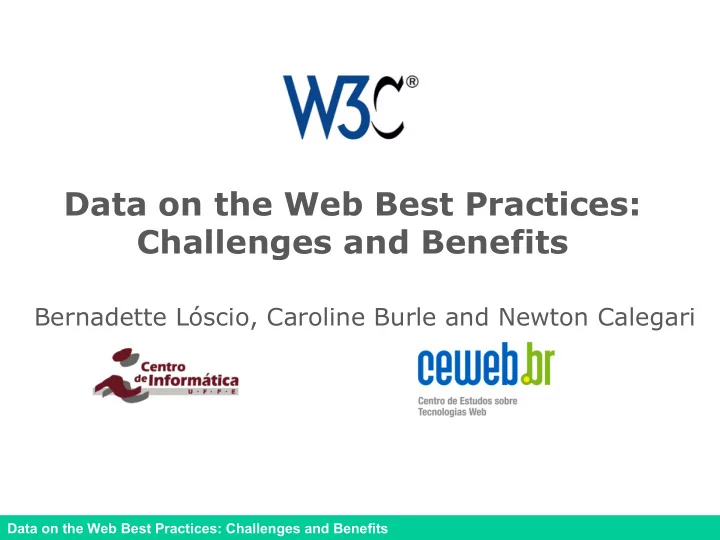

Data on the Web Best Practices: Challenges and Benefits Bernadette Lóscio, Caroline Burle and Newton Calegari Data on the Web Best Practices: Challenges and Benefits
Topics to be discussed • Data on the Web Context • Data on the Web use cases • Data on the Web Challenges and Requirements • Data on the Web Best Practices • Data on the Web Best Practices Benefits Data on the Web Best Practices: Challenges and Benefits
Data on the Web x Open Data x Linked Data Data on the Web Best Practices: Challenges and Benefits
Data on the Web Context Data on the Web Best Practices: Challenges and Benefits
Players of the data on the Web ecosystem Several types of data sources (transactional systems, sensors, mobile devices, documents … ) Data publisher: publishes and shares data Data consumer: reuses the data and might generate new data Source: http://ceweb.br/livros/dados-abertos-conectados/capitulo-1/ How to enable the data reuse? Data on the Web Best Practices: Challenges and Benefits
How to enable the data reuse? A common understanding between data publishers and data consumers becomes fundamental. Without this agreement, data publishers' efforts may be incompatible with data consumers' desires. Best Practices Consumes data Publishes data Data on the Web Best Practices: Challenges and Benefits
Data on the Web Best Practices Working Group The Mission of the Data on the Web Best Practices Working Group, part of the Data Activity, is: 1. to develop the open data ecosystem , facilitating better communication between developers and publishers; 2. to provide guidance to publishers that will improve consistency in the way data is managed, thus promoting the re-use of data; 3. to foster trust in the data among developers, whatever technology they choose to use, increasing the potential for genuine innovation. Source: https://www.w3.org/2013/dwbp/wiki/Main_Page: Data on the Web Best Practices: Challenges and Benefits
Data on the Web use cases https://www.w3.org/TR/dwbp-ucr/ Data on the Web Best Practices: Challenges and Benefits
Data on the Web use cases Data on the Web use cases Data on the Web Best Practices: Challenges and Benefits
How to make data available? How to make data Which data to interoperable? publish? Publishing data on the Which are How to the data Web identify data sources? resources? Which data How to formats to gather use? feedback? Publishing data on the Web is more than just publishing data! Data on the Web Best Practices: Challenges and Benefits
Data on the Web Challenges ▪ Metadata (for humans & machines) ▪ Data Licenses (how to permit & restrict access?) ▪ Data Provenance & Quality (how to add trust?) ▪ Data Versioning ( tracking dataset versions) ▪ Data Identification (identifying datasets and distributions) ▪ Data Formats (which data formats to use?) Data on the Web Best Practices: Challenges and Benefits
Data on the Web Challenges ▪ Data Vocabularies (how to promote interoperability?) ▪ Data Access (access options) ▪ Data Preservation ▪ Feedback (how to engage users?) ▪ Data Enrichment (adding value to data) ▪ Data Republication (reuse data responsibly) 12 challenges and 42 requirements Data on the Web Best Practices: Challenges and Benefits
https://www.w3.org/TR/dwbp/ Audience: BP are designed to meet the needs of information management staff, developers, and wider groups such as scientists interested in sharing and reusing research data on the Web Source: http://w3c.github.io/dwbp/bp.html Data on the Web Best Practices: Challenges and Benefits
Source: http://w3c.github.io/dwbp/bp.html#challenges Data on the Web Best Practices: Challenges and Benefits
DWBP Benefits Each benefit represents an improvement in the way how datasets are available on the Web Data on the Web Best Practices: Challenges and Benefits
BP Benefits ▪ Comprehension : humans will have a better understanding about the data structure, the data meaning, the metadata and the nature of the dataset. ▪ Processability : machines will be able to automatically process and manipulate the data within a dataset. ▪ Discoverability: machines will be able to automatically discover a dataset or data within a dataset. ▪ Reuse : the chances of dataset reuse by different groups of data consumers will increase. Data on the Web Best Practices: Challenges and Benefits
BP Benefits ▪ Linkability : it will be possible to create links between data resources (datasets and data items). ▪ Interoperability : it will be easier to reach consensus among data publishers and consumers. ▪ Trust: the confidence that consumers have in the dataset will improve. ▪ Access: humans and machines will be able to access up to date data in a variety of forms. Data on the Web Best Practices: Challenges and Benefits
How can you contribute now? Fonte: http://w3c.github.io/dwbp/dwbp-implementation-report.html Data on the Web Best Practices: Challenges and Benefits
Obrigada(o)! www.ceweb.br - www.cin.ufpe.br cburle@nic.br @carolburle @bernafarias bfl@cin.ufpe.br @newtoncalegari newton@nic.br Data on the Web Best Practices: Challenges and Benefits
Recommend
More recommend